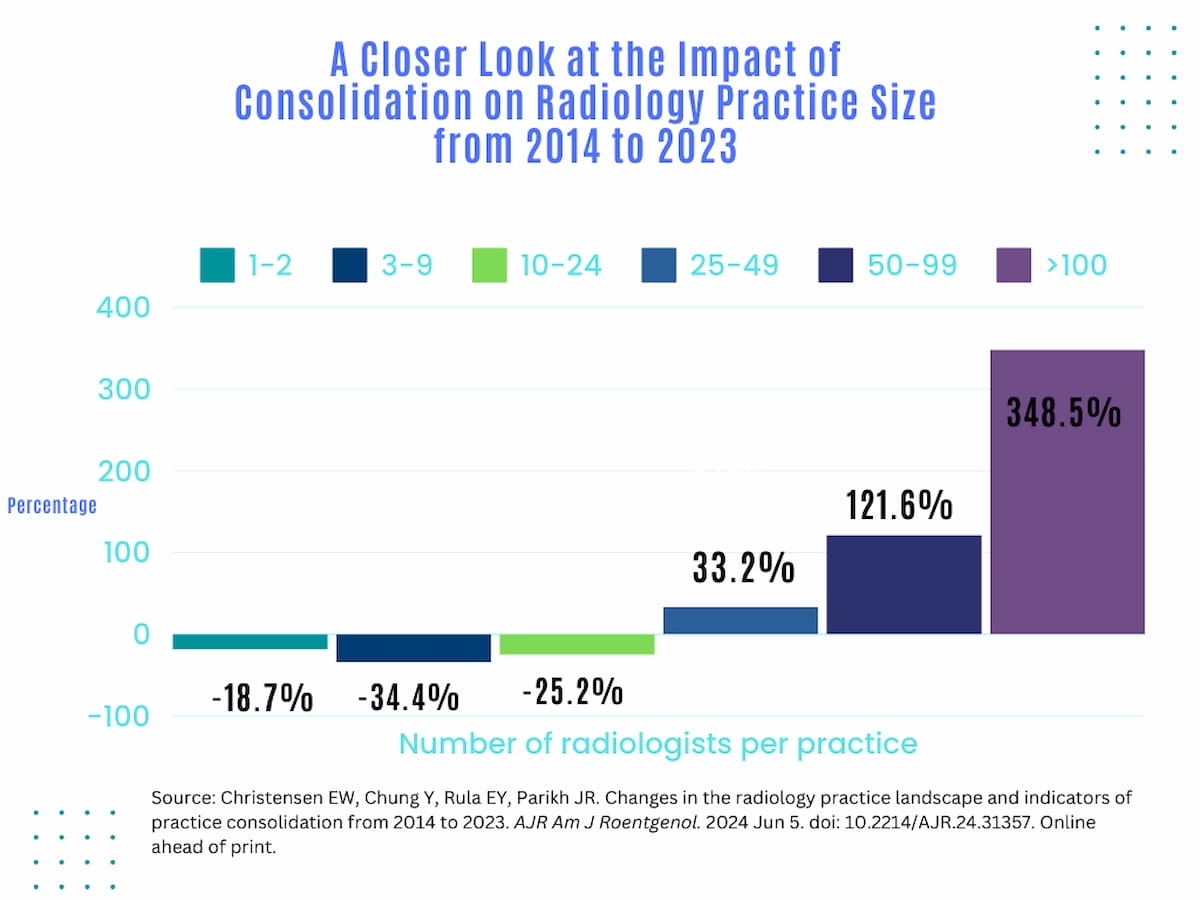Radiology Study Shows Nearly 350 Percent Increase of Practices with 100 or More Radiologists
There was over a 31 percent decline in radiology-only practices and over a 25 percent decrease of practices employing 10-24 radiologists, according to new research examining consolidation trends in radiology from 2014 to 2023.
In addition to showing substantial consolidation of radiology practices over the last decade, new research demonstrates that the vast majority of radiologists from smaller ceased practices were subsequently employed at radiology-only or radiology-majority practices while the majority of radiologists from larger creased radiology-only practices shifted to no-specialty-majority practices.
In order to assess consolidation trends in radiology, researchers examined data from the Centers for Medicare and Medicaid Services (CMS) from 2014 to 2023 for radiologists providing Medicare services.
Over the course of a decade, the researchers noted decreases of 418 one-to-two radiologist practices (18.7 percent), 483 practices with three to nine radiologists (34.4 percent) and 229 practices with 10 to 24 radiologists (25.2 percent). The study authors noted corresponding increases of 117 practices with 25 to 49 radiologists (33.2 percent), 152 practices with 50 to 99 practices (121.6 percent) and 115 practices with 100 or more radiologists (348.5 percent).
In a study examining the impact of consolidation in radiology, the authors noted increases of 117 practices with 25 to 49 radiologists (33.2 percent), 152 practices with 50 to 99 practices (121.6 percent) and 115 practices with 100 or more radiologists (348.5 percent).

While there was a 17.3 percent increase in the number of Medicare-enrolled radiologists during this time period (from 30,723 in 2014 to 36,024 in 2023), researchers noted a 14.7 percent decrease of affiliated practices (from 5,059 in 2014 to 4,313 in 2023).
“As practices’ mean number of affiliated radiologists increased, radiologists showed a shift away from practices with <25 radiologists toward practices with ≥25 radiologists. The largest change was observed for practices with ≥100 radiologists,” wrote lead study author Eric W. Christensen, Ph.D., the director of economic and health services research for the Harvey L. Nieman Policy Institute and adjunct professor of health services management at the University of Minnesota, and colleagues.
The researchers also pointed out a 31.8 percent decline in radiologists affiliated with radiology-only practices (from 3,104 in 2014 to 2,118 in 2023) and a 24.6 percent increase in radiologists affiliated with no majority specialty practices (from 938 in 2014 to 1,169 in 2023).
Specifically, 84.8 percent of radiologists from ceased practices with one or two radiologists were subsequently affiliated with radiology-only (70.5 percent) or radiology-majority practices (14.3 percent), according to the study authors. For those at ceased radiology practices with 50 or more radiologists, the researchers found that 26.2 percent opted for a radiology-majority practice while 54.7 percent were subsequently employed at a no-specialty-majority practice.
The study authors noted that benefits of larger practices include improved salary stability and more favorable reimbursement whereas other radiologists may opt for smaller, radiology-oriented environments to have more of a say in the direction of the practice.
“Larger practices can … leverage economies of scale to offer subspecialty care to remote areas, improve turnaround time, and enjoy operational and financial benefits. Larger practices may also leverage their size when negotiating payer contracts to counter insurers’ market power,” added Christensen and colleagues. “On the other hand, radiologists may prefer smaller, independent, and radiology-only practices in order to preserve opportunities for equity as well as autonomy and influence on practice structure, scheduling, and workplace culture.”
(Editor’s note: For related content, see “Current Perspectives on Radiology Workforce Issues and Potential Solutions,” “Assessing the Impact of Radiology Workforce Shortages in Rural Communities” and “Can Short-Term Measures Provide Some Relief with the Radiologist Shortage?”)
In regard to study limitations, the authors acknowledged possible inaccuracies with self-reported provider specialties in the data and noted a lack of information on physician-hospital integrated networks. There was also a lack of clarity as to whether radiologists from ceased practices stayed with the consolidated practice, according to the researchers.
The Reading Room Podcast: Emerging Trends in the Radiology Workforce
February 11th 2022Richard Duszak, MD, and Mina Makary, MD, discuss a number of issues, ranging from demographic trends and NPRPs to physician burnout and medical student recruitment, that figure to impact the radiology workforce now and in the near future.
Study Explores Impact of Insurance on Treatment and Referrals for Patients with Uterine Fibroids
February 19th 2025Women with uterine fibroids and Medicaid coverage are significantly more likely to be treated with uterine artery embolization than those with commercial insurance, according to newly published research.